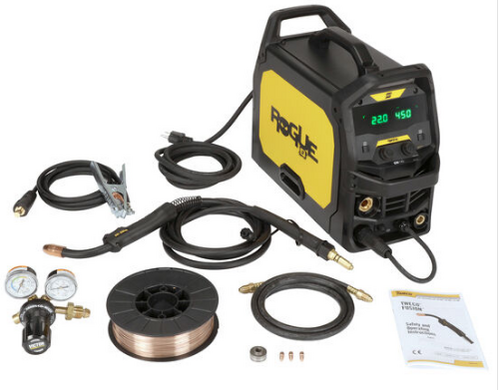Choosing Your First Welding Machine:

ESAB Rogue EM 140
ESAB Rogue EM 140 is an inverter-based MIG/MAG welding system designed to address all your welding project needs, from light fabrication to repair and maintenance. The system features industrial-grade arc performance and full featured controls that allow the welder to fine tune arc characteristics based on the material they are welding.
A Beginner’s Buying Guide
Understanding Your Welding Needs
Before diving into the details of different welding machines, let us take some time to assess our specific needs and requirements.
Ask yourself questions like:
- What types of projects do I plan to tackle?
- What materials will I primarily be welding?
- Do I need a portable machine or one that stays in a fixed location?
- What is my budget for purchasing a welding machine?
Understanding your welding needs will not only narrow down your options but also ensure that you invest in a machine that meets your expectations and requirements.
Types of Welding Machines
Welding machines come in various types, each suited for different welding techniques and applications. The three most common types of welding machines are:
Arc Welders
Arc welding, also known as stick welding, is one of the oldest and most straightforward welding techniques. Arc welders utilize a consumable electrode rod to create an electric arc between the electrode and the base material, forming the weld joint. These machines are versatile and suitable for welding a wide range of materials, including steel, stainless steel, and cast iron.
MIG Welders
Metal Inert Gas (MIG) welding, also known as Gas Metal Arc Welding (GMAW), is a popular welding process due to its speed and efficiency. MIG welders use a continuously fed wire electrode and a shielding gas to create the weld joint. These machines are versatile and suitable for welding a wide range of materials, making them ideal for both beginners and experienced welders alike.
TIG Welders
Tungsten Inert Gas (TIG) welding is a precise and intricate welding process that produces high-quality welds. TIG welders use a non-consumable tungsten electrode to create the weld joint, while a separate filler rod may be added to enhance strength and durability. TIG welding is ideal for welding thin materials and achieving clean, aesthetically pleasing welds.
Key Considerations When Choosing a Welding Machine
When selecting your first welding machine, it’s essential to consider several key factors to ensure you make an informed decision. These factors include:
Amperage: The amperage or current output of the welding machine plays a crucial role in determining the heat generated during the welding process. Higher amperage machines are suitable for thicker materials and longer welding durations.
Duty Cycle: The duty cycle refers to the amount of time a welding machine can operate continuously before needing to cool down. It’s essential to choose a machine with a duty cycle that aligns with your intended welding projects to avoid overheating and downtime.
Choosing the right welder requires some thought but with careful consideration and research, you will be well on your way to finding the right machine for your specific needs.
As you embark on your welding journey, keep in mind the wise words of seasoned welders:
“The two key factors to consider are amperage and duty cycle. It’s important to balance the amount of time you’ll be welding with the machine’s need to cool down.”
For further guidance on choosing the right welding machine, check out this comprehensive guide: The Ultimate Guide to Choosing the Right Welding Machine.
Essential Features to Look for in a Welding Machine
Now that we’ve covered the basics of welding machine types and key considerations, let’s dive into some essential features to look for when choosing your first welding machine:
1. Voltage Control
A welding machine with adjustable voltage control offers greater versatility and precision, allowing you to tailor the welding parameters to suit different materials and thicknesses. Look for machines with variable voltage settings to accommodate a wide range of welding applications.
- Wire Feed Speed Control (For MIG Welders)
For MIG welding machines, wire feed speed control is essential for achieving optimal weld bead appearance and penetration. Adjustable wire feed speed allows you to control the rate at which the electrode wire is fed into the weld puddle, ensuring consistent weld quality across various welding conditions.
- Portability and Size
Consider the portability and size of the welding machine, especially if you anticipate moving it frequently or working in tight spaces. Compact and lightweight machines are ideal for on-the-go welding projects, while larger machines may offer additional features and capabilities suited for stationary workshops.
- Safety Features
Safety should always be a top priority when working with welding equipment. Look for machines equipped with safety features such as thermal overload protection, which automatically shuts off the machine in the event of overheating, and built-in shielding gas regulators to ensure proper gas flow and weld quality.
- Ease of Use and Setup
As a beginner welder, you’ll want a machine that is easy to set up and use, with intuitive controls and clear instructions. Look for machines with user-friendly interfaces and straightforward setup procedures to minimize frustration and maximize productivity during your welding projects.
Final Considerations
In addition to the essential features mentioned above, here are some additional considerations to keep in mind when selecting your first welding machine:
Brand Reputation: Research reputable welding machine brands known for their quality, reliability, and customer support.
Warranty and Support: Look for machines backed by a comprehensive warranty and reliable customer support to address any issues or concerns that may arise.
Budget: While it’s essential to invest in a high-quality welding machine, consider your budget constraints and look for machines that offer the best value for your money.
Following these considerations, you’ll be well-equipped to choose the welding machine to begin your welding journey.
